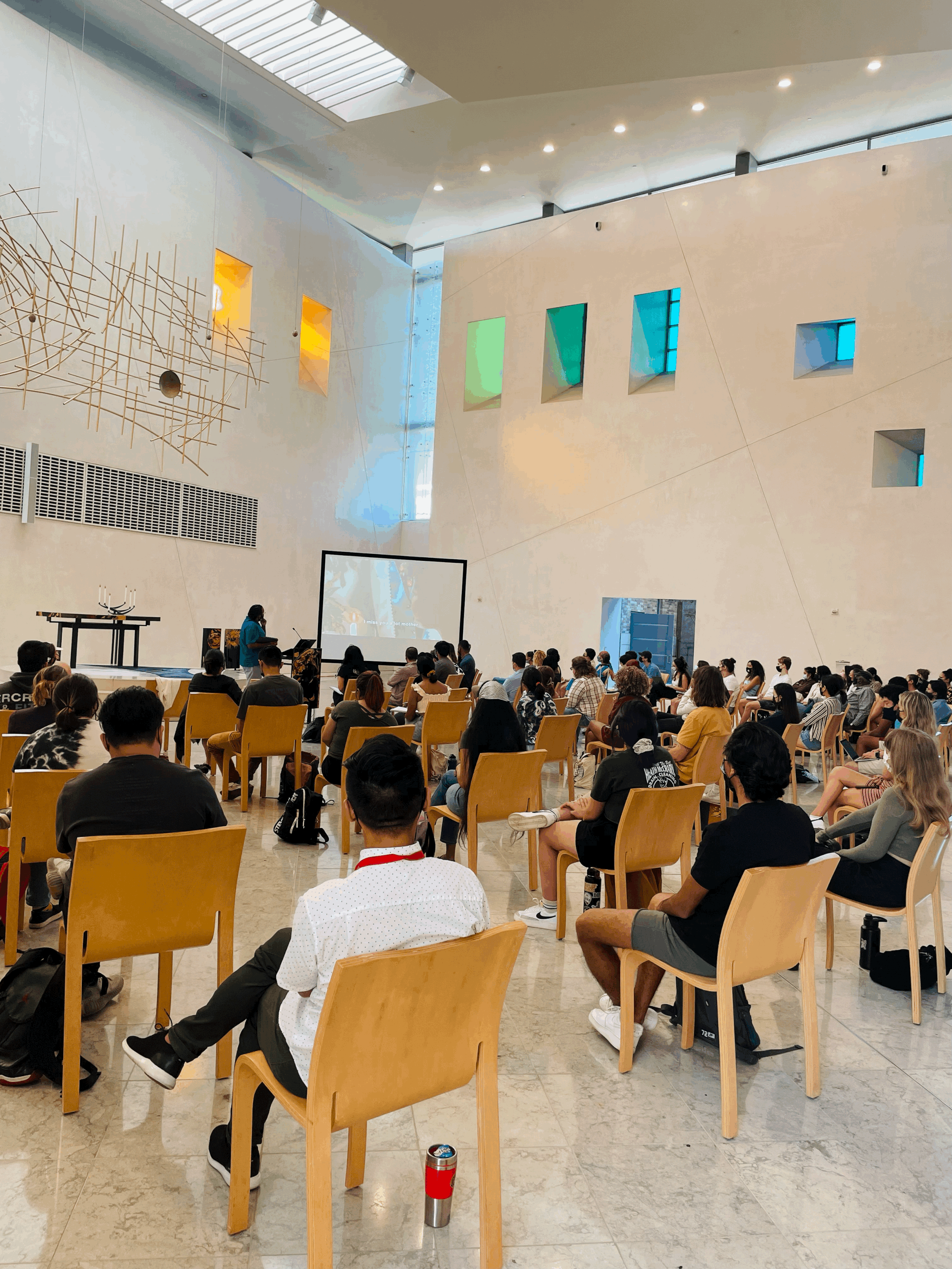Entangled histories: ‘Indigenous Blackness’ lecture highlights complexity of identity
Black, Indigenous and Latinx: what are the limits of a label? This question sat at the heart of “A Love Letter to Indigenous Blackness,” an Oct. 28 lecture hosted on Chapman campus by Paul Joseph López Oro, an assistant professor of Africana Studies at Smith College in Massachusetts.
A sea of Chapman University students surrounded López Oro in the Wallace All Faiths Chapel as he explained the complex heritage of the Garifuna people. Descended from the African survivors of shipwrecked slave ships and indigenous Caribbean groups like the Arawak, the Garifuna people fall at the intersection of several identities, including Latin American, Black and Indigenous.
A crowd of students gathered in Chapman’s Wallace All Faiths Chapel for an Oct. 28 lecture. Photo courtesy of Angelica Allen
It can be difficult to preserve a Garifuna identity when societies focus on those broader labels, noted López Oro, a second-generation Garifuna Honduran. When Garifuna people partake in something like the New York census, for instance, some feel conflicted about picking which race box to mark — some choose “Hispanic” because they speak Spanish, while others choose “Black” based on their skin color.
“One thing that we can always say the United States has is a racial binary; it’s very black and white,” López Oro said at the event. “I would always (encourage) students to think beyond (that) binary.”
The presentation then exemplified how rigid definitions of identity have been an obstacle for the Garifuna community. Compared to New York, which has the largest population of Garifuna people outside Central America, López Oro told his audience the West Coast has a “Latinidad that looks different … (where) we don’t imagine Black people to be Spanish-speaking.”
Beyond the U.S. borders, the difficulties of categorizing Indigenous Black communities still exist.
“In a Central American context, Black people come from somewhere else,” López Oro said at the lecture, emphasizing that anti-Black and anti-Indigenous attitudes are still present in Central America. “To become a mestizo (defined in Central and Latin America as a person of combined Indigenous and European extraction) is really violent in this racial discourse. You give up your indigenous culture, your indigenous language (and) your indigenous identity.”
But López Oro was quick to mention in his presentation that Garifuna communities have resisted this racial binary, detailing how Garifuna New Yorkers have expertly “marked space” even if their presence in the city was never imagined to be part of that space.
At the event, Paul Joseph López Oro demonstrated the limitations of categorizing the Garifuna people in broad terms like “Black” or “Latin American.” Photo courtesy of Angelica Allen
“Marking space” for Garifuna New Yorkers meant “articulating Indigenous Blackness” through land ownership or cultural expression, López Oro told the students. If ancestral Garifuna lands were not accessible physically for those in New York, he reasoned, they have become accessible for Garifuna New Yorkers through celebration and culture instead.
To preserve Garifuna multiculturalism and its story, López Oro argued nationalism and colonialism are best left in the past. The embodiment of Garifuna history through performance and ancestral memory, for instance, would be preferable to historical records that López Oro said adopt an oppressive, colonial perspective.
“There’s a tendency (for) historical accuracy (to be) really European-centered,” López Oro said, “Whatever little archive Garifuna folks have … is very much (a) colonial archive that has erased and silenced the histories of Garifuna folks.”
The event also detailed the matrilineal structure of Garifuna culture, the various distinctions between Garifuna people and African Americans and a history of Black communities in Latin American countries like Mexico.
The presentation was hosted by the Africana studies minor within the Wilkinson College of Arts, Humanities and Social Sciences and co-sponsored by the Latinx and Latin American studies minor. Angelica Allen, director of the Africana studies minor, functioned as the organizer of the Oct. 28 event.
For Adwoa Opong, an assistant professor of African history at Chapman, López Oro’s words spoke to the heart of Africana studies.
“As teachers, we want our students to take away the intersecting nature of the Black experience — the idea that the world is fluid,” Opong told The Panther. “You cannot talk about the African diaspora in New York without talking about the Garifuna community.”
Just as López Oro highlighted the intricacies of Garifuna culture and history, Opong noted that the Garifuna community is only one fragment of the global Black experience observed in Africana studies. But for some, it’s a fragment that hadn’t come into view until “A Love Letter to Indigenous Blackness.”
When asked about the importance of lectures like López Oro’s, Opong had a simple answer: “These talks take us to worlds we are not familiar with.”


